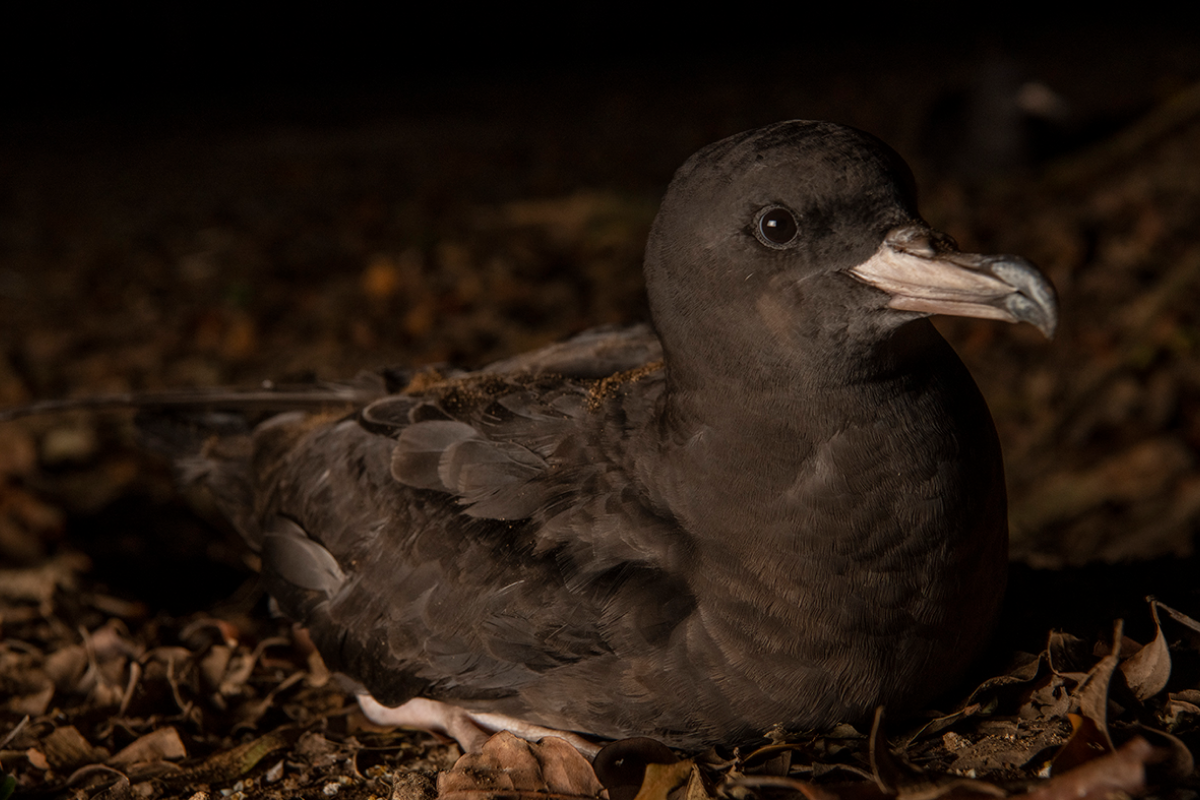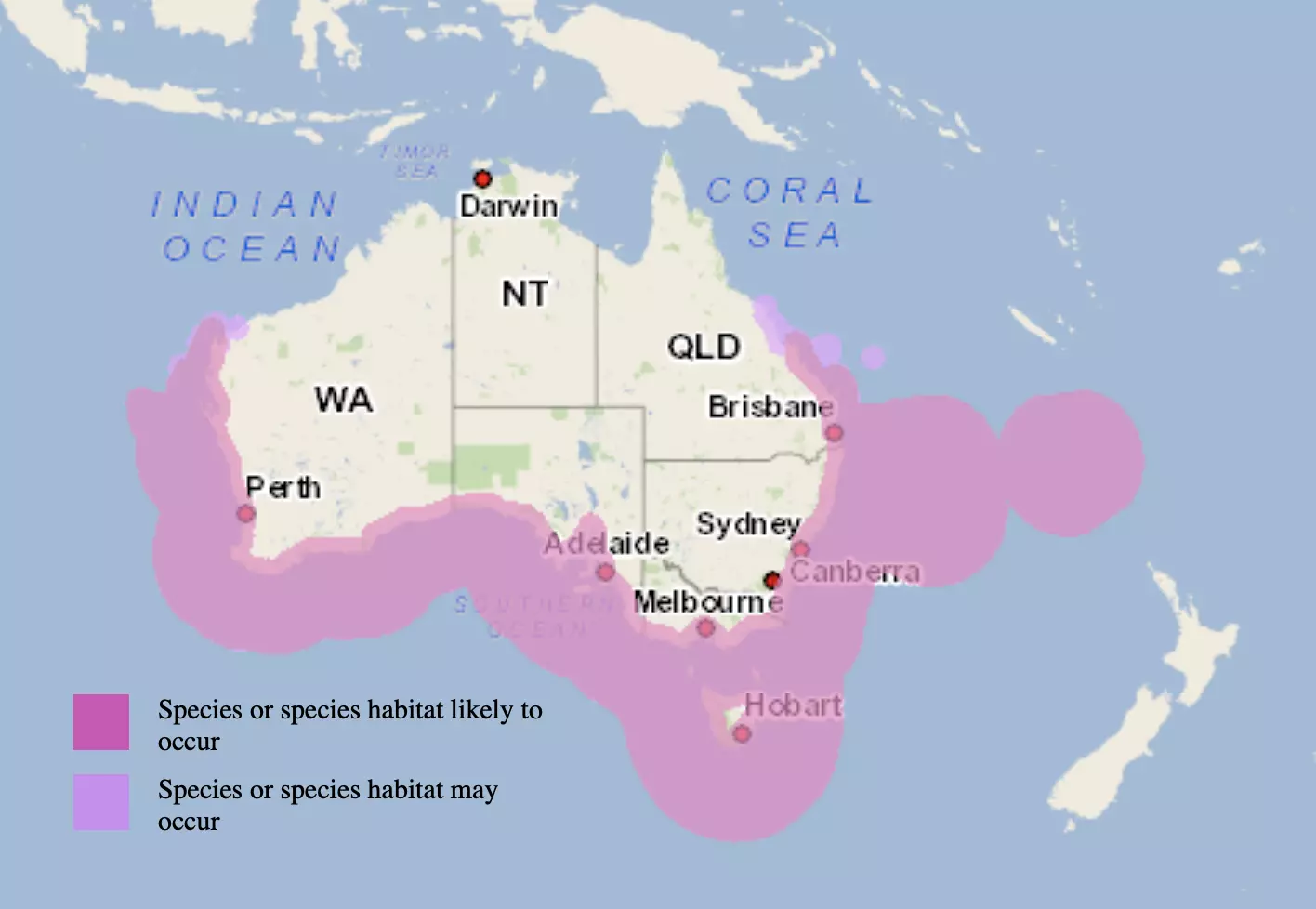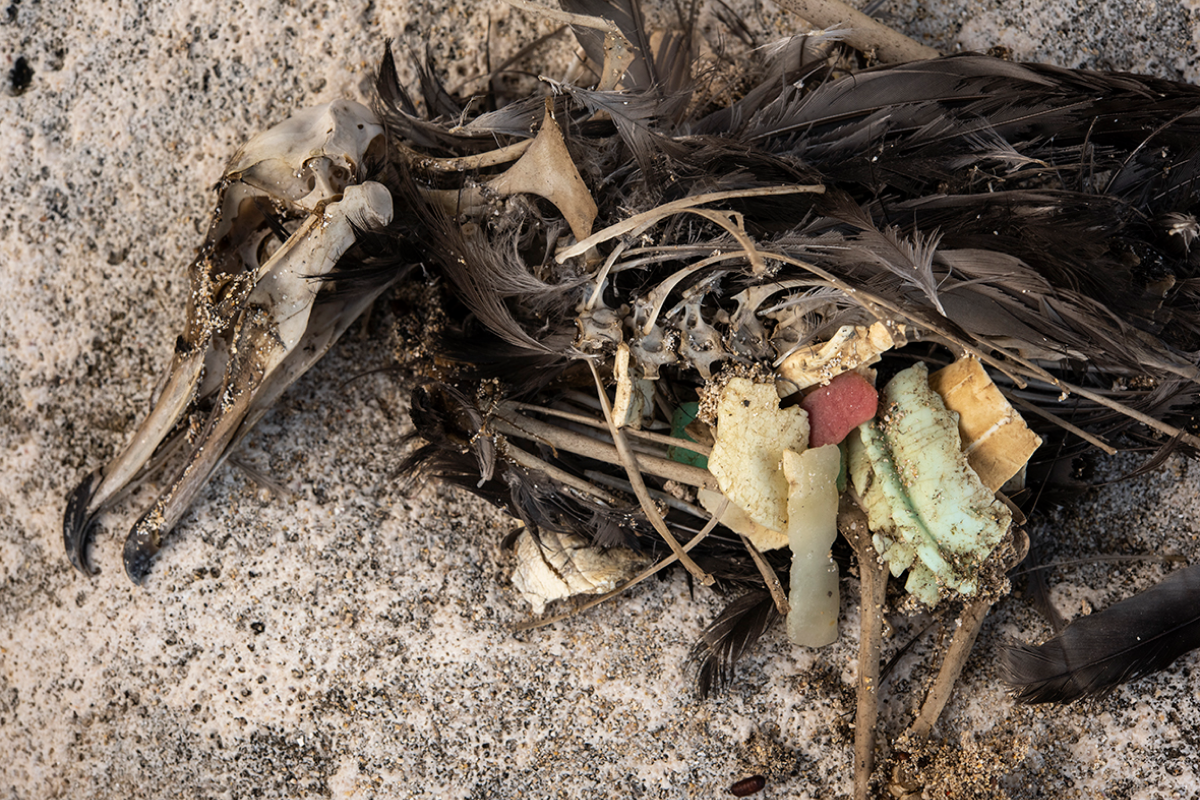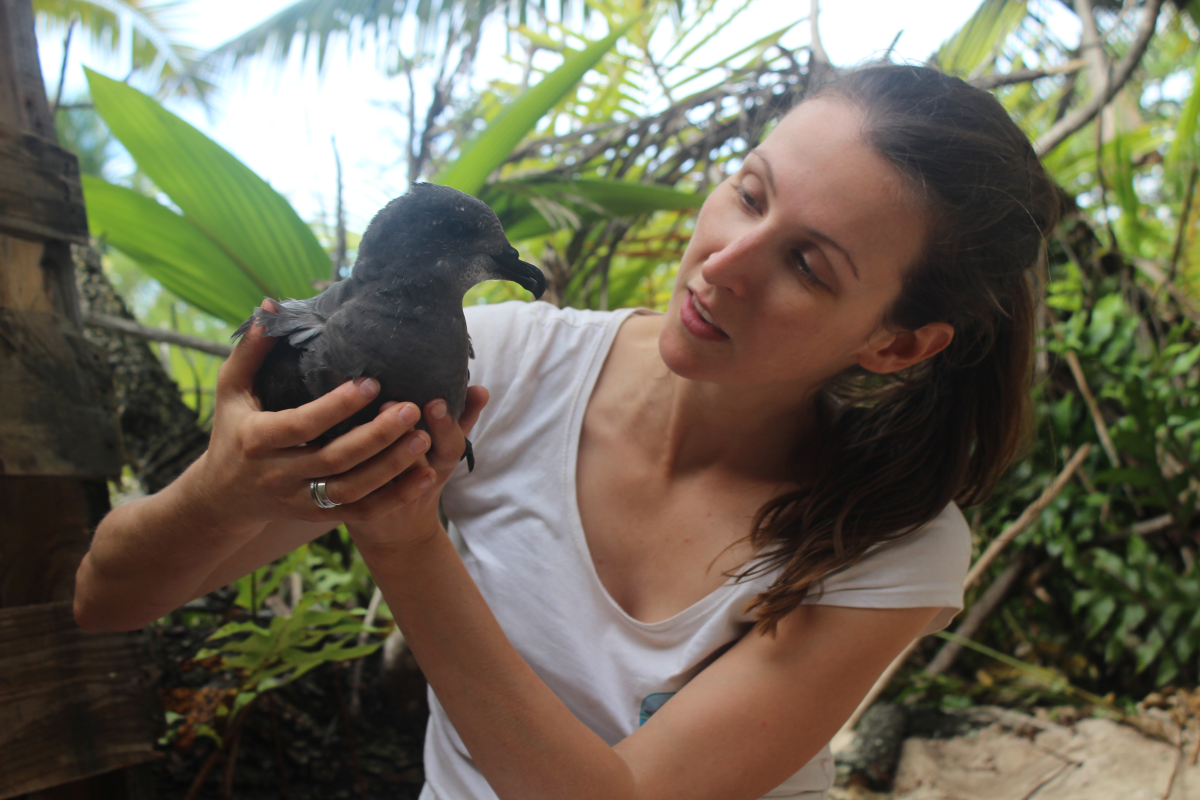The sorrow
of shearwaters
Plastic pollution in the ocean is now a leading threat to sea bird survival worldwide and 40,000 shearwaters nesting each year on Lord Howe Island are sounding the alarm.

Plastic pollution in the ocean is now a leading threat to sea bird survival worldwide and 40,000 shearwaters nesting each year on Lord Howe Island are sounding the alarm.

They reach Lord Howe Island in their thousands early in September each year – long-winged, chocolate-coloured birds, slightly bigger than silver gulls, with light bills and pink legs and feet.
Coming from 10,000km away near the Sea of Japan, they reach Lord Howe – 700km northeast of Sydney – by flying non-stop for 10 or more days without eating. By the time they get here they’re exhausted and hungry.
Seemingly timing their arrival for dusk, they circle at first in the air over the island like fighter bombers.
Then as the last rays of sunlight disappear, they fold their wings and drop from the sky under the cover of darkness.
Ever elegant in the air they may be, but these birds fall to earth like dead weights landing, seemingly randomly, on the island with a thud.
But these descents from the sky are highly targeted and the birds usually land within metres of the same nesting site that they’ve used before – burrowed out in a previous year on the sandy floor of the Lord Howe Island forest.
The species has probably been doing the same for millennia.
How they pinpoint these burrows so precisely is not completely understood. But shearwaters have exceptional eyesight, an extraordinary sense of smell and something far beyond the usual five senses available to most mammals.
“They seem to have a kind of amazing mental map in their mind of exactly where their burrow is and, although they can’t actually see it because it’s hidden by the forest canopy, they use some sort of precision-GPS system to find it,”
explains Dr Jennifer Lavers, an expert in seabird ecology who’s been working with the Lord Howe Island flesh-footed shearwater colony for almost 15 years.
All these navigational skills clearly work on the large scale too, enabling shearwaters to navigate vast distances with no apparent visual landmarks to use as guides.
“They navigate thousands of kilometres of open ocean as if they have a perfectly drawn map of the world locked in their brains,” Jennifer says. “It would be incomprehensible to us – travelling between Japan and Australia with no map or GPS system – but for these birds it’s like taking a trip to the grocery store.”
If they live a charmed life and survive to their species’ potential these birds will return each year like this to meet up with the same partner and use the same burrow to raise young for as many as 40 years.

Research scientist Jenn Lavers has spent the past 15 years focused on the impact marine ocean plastic pollution has on seabirds, particularly on the breeding colony of flesh-footed shearwaters on Lord Howe Island, off the NSW mid north coast.
Ardenna carneipes









Shearwaters rarely flap their wings. Like many seabirds that migrate vast distances across open oceans, they have a highly evolved, strategic way of flying that conserves energy. After locking their wings in place using tendons in the shoulders, they soar on wind currents close to the ocean surface.
The islands around Australia support nesting colonies of four different species of shearwater. The colony of this species, the flesh-footed shearwater, on Lord Howe numbers about 22,000 breeding pairs.
Shearwaters mate for life but spend the non-breeding months apart feeding in the Northern Hemisphere, avoiding the cold of the Southern winter.
As for many other seabirds, shearwaters are supreme fliers, able to soar, low and indefinitely like fixed wing aircraft, in air currents circulating over ocean waters.
“They have an incredibly strategic way of flying called ‘slope soaring’ that is highly evolved to be extremely efficient,” Jennifer explains. “There are two things that you’ll rarely see seabirds doing – flapping their wings or flying when it isn’t windy.
“And the reason for that is that they lock their wings into position using tendons in their shoulders so that once their wings are open they don’t have to expend any energy keeping them open.
“And then they use ‘wind eddies’ off the tips of ocean waves to give them all the propulsion and the lift that they need to send them forward.”
And so, when it’s not windy, you’ll see shearwaters bobbing on the ocean, waiting for a breeze.


It’s not known exactly how shearwaters find their mates and chicks in a breeding colony with more than 40,000 birds. But sight, sound and smell are undoubtedly all important. For that reason, researchers move through these places with exceptional care not to alter any aspect, even the position of a tiny twig or rock.
At sea these birds are almost silent, in vast contrast to their colonies, which are raucous, seemingly disorderly places. But every adult knows its partner, its burrow, its egg and then later its chick – and they find their way and their family members using at least sight smell and, quite clearly, sound.
In the air they’re consummate fliers. But on land their movements look clumsy in comparison, as they shuffle through the forests on their fleshy feet to the entrances of their burrows.
But when they find their partners at the beginning of the season, an elegance returns to their movements. They court and preen each other, with what seems almost like tentative affection, moving in unison, arching their necks, and bobbing their heads in a dance that can last for hours at a time.
“They don’t associate with one another while over the Sea of Japan, so this courtship is a big part of reuniting at the start of the breeding season,” Jennifer says. “Their displays, calling, dancing, preening each other – it’s about re-establishing the pair bond after not seeing each other for three or four months.”
Each flesh-footed shearwater pair lays just one egg each season. If lucky they’ll manage to replace themselves once every two years.
Couples share equal time, first incubating the egg and, later, feeding the chick.
The nests are created at the end of a 1-to-2m long burrow. At first one adult will remain with the young.
But as the chicks grow and need more food they’re left alone in the burrow during the day while both parents take off to forage.
When not in the nest the adults are out feeding over the Tasman Sea, looking for fish, crustaceans, squid, and anything else that looks or smells edible.
Shearwaters can smell a school of fish a kilometre away and then, also guided by sight, dive into the water and chase their prey sometimes more than 10m below the water’s surface.
And this is where this extraordinary story of survival takes one of its many dark twisted turns for the worse. It’s not only marine creatures that shearwaters take on these foraging expeditions west of their island home, but increasingly pieces of plastic.


A medium-large uniformly dark brown shearwater with long relatively broad wings, a long pointed tail in flight, a pink-white bill with sharply hooked dark tip, and white-flesh coloured legs and feet that sometimes show pinkish webbing when landing on water. Individuals are typically solitary at sea, although flocks of hundreds of birds can form around sources of food, and at dusk when individuals raft together offshore from their breeding islands.
Flesh-footed shearwaters feed on small fish caught by shallow dives into shoals, or occasional deeper dives reaching 30 m in depth. They sometimes eat small squid. Chicks are fed 80-90 g meals every 2-3 days on average.
OTHER NAMES
Pale-footed shearwater, Fleshfooted shearwater
VOICE
The calls of flesh-footed shearwaters resemble cats fighting, with loud wailing and moaning.
Flesh-footed shearwater distribution

It’s not yet known whether these bits of plastic are picked up accidentally by shearwaters or targeted deliberately because they glisten and shine like fish or squid. But it’s now thought that this is contributing to a loss of seabirds worldwide.
“Within an hour of arriving on the island and on my first trip to the colony I found plastics scattered all over the colony floor – bits of pens and bottle caps, and all kinds of other plastic things – and realised straight away that there was a problem,” Jennifer recalls. “From that point on plastics became the focus of what I did.”
There’s now evidence that this Lord Howe Island population of flesh-footed shearwaters has declined by as much as 29 per cent in just three generations.
But it’s not caused only by plastic pollution. There are other threats contributing to the decline of not only this species but to almost all seabird species worldwide.
Certainly, commercial fishing is partly to blame. And that’s what Jennifer first came here to study in 2007.
The birds become bycatch when they take baits on long lines set for tuna and other commercially valuable fish species.


Bottle caps, nurdles (resin pellets), glow sticks and building items such as tiling spacers and wall plugs are all commonly found in the guts of shearwaters. But, Jenn says, what’s most abundant are fragments of plastic. “I can’t tell you what they come from or how old they are – just fragments of everything plastic that’s ever been manufactured in the last 70 or 80 years,” she says of what she finds in the guts of the many dead seabirds, upon which she conducts necropsies.
Habitat destruction caused by development on Lord Howe Island is another major threat.
So too are feral pests, such as rats, that take eggs and nestlings.
But research is now increasingly showing that plastics in the ocean is playing a major role in the decline of this species.
These birds don’t only get caught up in and drown in large pieces of plastic rubbish.
They target and ingest small bits of plastic floating in the ocean because it looks like prey in the water – small fish, squid or crustaceans.
This plastic is eaten by adults, who then instinctively regurgitate it - if they can - to feed to their young.
Hatchlings end up with bellies full of indigestible plastic. As a result, young birds have been found to have impaired kidney function, raised cholesterol levels, reduced body mass, wing length and head and bill length.
Many hatchlings now never leave the island. They die here malnourished and in pain.

Gently flushing a saline solution into the stomachs of seabirds helps them to regurgitate the plastics they have swallowed. This has an immediate effect with treated birds quickly showing showing signs of better nutrition.
Seabirds generally are the most threatened of all birds and plastics in the oceans are now seen as one of the major reasons why.
Most of the plastic in the bellies of Lord Howe Island flesh-footed shearwaters comes from industrial sources.


Seabirds are the most vulnerable bird group worldwide. About a third of all 328 known species are threatened of which five are already thought to be extinct. However, seabirds respond well to small- to-mid-scale conservation actions, meaning grassroots work such as beach clean-ups, can improve their chances of survival.
The main categories of plastic found in shearwater guts are:
To exactly what extent is ocean plastic pollution affecting the survival of flesh-footead shearwaters and other seabird species?
“It’s having a devastating impact,” Jenifer agrees. “But is it the main driver of the decline? We just don’t’ know yet.”
“That’s the monumental challenge for scientists – to try and tease apart all the various threats and be able to say which one is worse than the other.”
Text by Karen McGhee, Photography by Justin Gilligan, Footage by Karina Holden, Design by Mike Ellott and Dawid Młynarz, Animations by Jonathan Goldrick. Additional research by Chrissie Goldrick. Photo research by Nicky Catley. Produced by Elizabeth Ginis and Angela Heathcote.